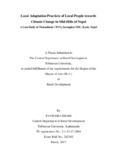Please use this identifier to cite or link to this item:
https://elibrary.tucl.edu.np/handle/123456789/2174| Title: | Local Adaptation Practices of Local People towards Climate Change in Mid-Hills of Nepal |
| Other Titles: | A Case Study of Thotnekhola CFUG, Sarangkot VDC, Kaski, Nepal |
| Authors: | Shahi, Pavindra |
| Keywords: | Climate Change;Temperature;Agriculture |
| Issue Date: | Mar-2017 |
| Publisher: | Central Department of Rural Development Tribhuvan University, Kathmandu |
| Abstract: | Study of Local Adaptation Practices of Local People towards Climate Change in Mid-Hills of Nepal: A Case Study of Thotnekhola CFUG, Sarangkot VDC, Kaski, Nepal was conducted in Thotnekhola CFUG of Kaski district. The general objective of the study was to assess the adaptation practices and problems occurred during applying it at the local level. The specific objectives were to analyze the situation of Climate Change (in terms of temperature and rainfall), to explore the adaptation measures (in agriculture) used by people and to examine the problems of applied adaptation measures faced by people (with reference to CAPA). In this study area, out of 153 HHs of the CFUG, 52 HHs were selected with the method of stratified random sampling for the study. And data were collected from field survey using household survey questionnaire, FGD, KII and direct observation tools then tabulate this data and make report through analysis. Regarding the experience on CC of local inhabitants, 100% respondents have experienced increasing temperature and 94% respondents have experienced unusual rainfall events or decreasing. Local people are practicing adaptation measures such as plantation and bioengineering against Landslide and Flood, water pond (Kuwa) conservation, rain water and kitchen water harvest, crop variety & sowing time change, soil fertility improvement, bedding, agroforestry and technology change against Drought and seed save and occupation change against Hailstone. Only 42% respondents believed on the CAPA can address the problems induced by CC. Like this, only 6 % respondents felt that the CAPA is implemented perfectly and also agreed to the causes of ineffective of CAPA implementation were political instability (35 %), lack of required fund (33 %), non-realistic plan (22 %) and lack of skilled manpower (10 %). Most of respondents facing problem during practicing adaptation measures against flood, landslide, drought and hailstone was technical problem among financial, technical, material and skilled manpower problems. |
| URI: | http://elibrary.tucl.edu.np/handle/123456789/2174 |
| Appears in Collections: | Rural Development |
Items in DSpace are protected by copyright, with all rights reserved, unless otherwise indicated.

